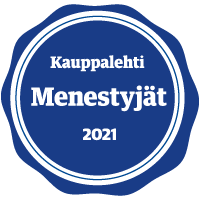Thermal Imaging Expert Thermidas Ensures Reliable Deliveries with the Help of Domestic 3D Printing
Thermidas is a thermal imaging expert whose devices are widely used in both human and veterinary medicine.
Thermidas’ thermal imaging technology helps healthcare professionals identify, for example, Charcot foot, pressure ulcers, and circulatory disorders. In veterinary medicine, the method can be used to detect the location and extent of injuries completely painlessly.
“Our devices are used in nearly all of Finland’s university hospitals and in many private clinics — also abroad,” says Thermidas’ Sales and Marketing Assistant Tiina Myllykangas.
Myllykangas has a versatile role within the company. In addition to sales and marketing tasks, she also takes part in device assembly — particularly for the IRT-384 Tablet product. For this reason, she has played a key role in the collaboration with Materflow, which 3D prints essential thermal camera mounting components for the tablet.

Durability of Prints as a Decisive Factor – Finding the Right Solution Through Challenges
3D printing was chosen as the manufacturing method for the IRT-384 Tablet’s protective parts because of its speed and its suitability for small-batch production. Durability is crucial for the tablet casings. The first 3D printing partner, however, was unable to produce shells durable enough for Thermidas’ needs.
“The devices can be dropped or bumped, especially in veterinary use, so the casings must be strong enough to protect the device,” Myllykangas explains.
The search for a new partner led to Materflow, a 3D printing company based in Lahti. With Materflow’s powder bed printing method, the prints became more durable. In addition, Materflow offered PA 12 Grey plastic, which provides sufficient durability for protective covers and enclosures and is also suitable for medical devices.
Initially, there were also some quality issues with Materflow’s prints: the first ones were warped and therefore didn’t fit the tablets properly. Once the issue was identified, Myllykangas traveled to Lahti to discuss the problems directly with the Materflow team.
“I brought some of the defective parts with me, and together we carefully reviewed the dimensions and requirements. Materflow’s Timo Peltonen explained thoroughly and precisely what the problem was and what might have caused it,” says Myllykangas.
According to Materflow’s Timo Peltonen, warping is a common challenge when printing large surface areas. As a print is completed, one end may start to cool while the other is still being printed. The uneven cooling can cause the print to warp. However, the issue can be addressed in various ways — for instance, by adding other prints to the same job to balance the heat distribution during printing.
For Thermidas’ product, Materflow and Myllykangas went through which dimensions in the protective casing were critical. By testing different printing orientations and making use of “warping” techniques, they found a way to keep the prints dimensionally stable and in shape.
Domestic Production Ensures Delivery Reliability and Enables a Fast Product Development Process
A domestic manufacturing partner guarantees delivery reliability even as global conditions, supply chains, and customs practices continue to change. Thermidas has also observed that such global changes are now happening faster than ever.
For example, when ordering parts from Asia, delivery times can be 2–3 months. According to Myllykangas, this waiting time is already too long for Thermidas — and in that time, a lot can happen. It has become necessary to prepare for rapid changes in regulations and practices.
“Right now, we even have parts ordered from abroad stuck in customs clearance, with delivery delayed due to new customs procedures,” Myllykangas notes.
“Domestic production is a major advantage for us. With Materflow, we can trust that the parts will arrive on time.”
In the field of medical technology, new innovations are constantly being developed, and Thermidas is continuously engaged in product development. A new type of device is currently in development and is expected to enter the market within three years. Developing and testing new products also requires rapid prototyping — an area where domestic 3D printing is an excellent option.
“The need for new parts can arise quickly. In such cases, we are happy to rely on Materflow,” says Myllykangas.
More information: thermidas.fi and thermidasvet.com





